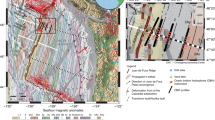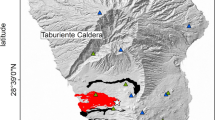Abstract
Since the advent of plate-tectonic theory over 30 years ago1,2, the geometries of subduction zones have been constrained mainly by the spatial distribution of earthquake hypocentres, known as Wadati–Benioff zones. This is due to the fact that, despite the existence of a wealth of shallow seismic reflection and refraction data, very few high-resolution images of deep subduction-zone structure have been obtained. The few attempts to image these structures (see, for example, refs 3,4,5) were restricted to marine surveys, with the exception of one experiment6,7, and none of these studies was successful at mapping structure to more than 30–40 km depth. The association of intermediate-depth earthquakes with a given layer of subducting oceanic lithosphere has therefore remained largely unresolved8. Here we report seismic reflection and refraction data across the central Andean subduction zone, which image the subduction boundary to a depth of 80 km. We show, by comparing the location of this boundary with earthquake hypocentres precisely located by a temporary seismic array in the region, that most of the intermediate-depth seismicity is offset into the subducting oceanic mantle, rather than lying within the crust or on the subduction-zone boundary itself, as has often been assumed.
This is a preview of subscription content, access via your institution
Access options
Subscribe to this journal
Receive 51 print issues and online access
$199.00 per year
only $3.90 per issue
Buy this article
- Purchase on Springer Link
- Instant access to full article PDF
Prices may be subject to local taxes which are calculated during checkout




Similar content being viewed by others
References
Isacks, B., Oliver, J. & Sykes, L. R. Seismology and the new global tectonics. J. Geophys. Res. 73, 5855–5899 (1968).
Dewey, J. F. & Bird, J. M. Mountain belts and the new global tectonics. J. Geophys. Res. 75, 2625–2647 (1970).
Davey, F. J. & Stern, T. A. Crustal seismic observations across the convergent plate boundary, North Island, New Zealand. Tectonophysics 173, 283–296 (1990).
Lundberg, N., Reed, D. L., Liu, C. -S. & Lieske, J. J Forearc-basin closure and arc accretion in the submarine suture zone south of Taiwan. Tectonophysics 274, 5–23 (1997).
Snyder, D. B. et al. Adual doubly vergent orogen in the Banda Arc continent-arc collision zone as observed on deep seismic reflection profiles. Tectonics 5, 34–53 (1996).
Green, A. G. et al. Seismic reflection imaging of the subducting Juan de Fuca plate. Nature 319, 210–213 (1986).
Clowes, R. M., Yorath, C. J. & Hyndman, R. D. Reflection mapping across the convergent margin of western Canada. Geophys. J .R. Astron. Soc. 89, 79–84 (1987).
Kirby, S., Engdahl, E. R. & Denlinger, R. in Subduction Top to Bottom 195–214 (eds Bebout, G. E., Scholl, D. W., Kirby, S. H. & Platt, J. P.) (Geophys. Monogr. 96, Am. Geophys. Union, Washington DC, (1996)).
Wigger, P. J. et al. in Tectonics of the Southern Central Andes (eds Reutter, K.-J., Scheuber, E. & Wigger, P. J.) (Springer, Berlin, (1994)).
CINCA Working Group in Abstr. Vol. III, VII, Congreso Geologico Chileno 1818–1822 (Universidad Catolica del Norte, Antofagast, (1997).
v. Huene, R., Weinrebe, W. & Heeren, F. Subduction erosion along the northern Chile margin. J.Geodyn.(in the press).
Rutland, R. W. R. Andean orogeny and ocean floor spreading. Nature 233, 252–255 (1971).
Lamb, S., Hoke, L., Kennan, L. & Dewey, J. in Orogeny through Time (eds Burg, J. P. & Ford, M.) 237–264 (Spec. Publ. 121, Geol. Soc., London, (1997)).
DeMets, C., Gordon, R. G., Argus, D. F. & Stein, S. Current plate motions. Geophys. J. Int. 101, 425–478 (1990).
Cahill, T. & Isacks, B. L. Seismicity and shape of the subducted Nazca plate. J. Geophys. Res. 97, 17503–17529 (1992).
Beck, S. L. et al. Crustal-thickness variation in the central Andes. Geology 24, 407–410 (1996).
Comte, D., Roecker, S. W. & Suárez, G. Velocity structure in northern Chile: evidence of subducted oceanic crust in the Nazca Plate. Geophys. J. Int. 117, 625–639 (1994).
Engdahl, E. R., Van der Hilst, R. D. & Buland, R. P. Global teleseismic earthquake relocation with improved travel times and procedures for depth determination. Bull. Seismol. Soc. Am. 88, 722–743 (1998).
Poli, S. & Schmidt, M. W. H2O transport and release in subduction zones: experimental constraints on basaltic and andesitic systems. J. Geophys. Res. B 100(11), 22299–22314 (1995).
Peacock, S. M. Thermal effect of metamorphic fluids in subduction zones. Geology 15, 1057–1060 (1987).
Toksöz, M. N., Minear, J. W. & Julian, B. R. Temperature field and geophysical effects of a downgoing slab. J. Geophys. Res. 76, 1113–1138 (1971).
Springer, M. Heat flow density pattern and implications for the thermal structure of the Central Andean crust. Tectonophysics(submitted).
Ulmer, P. & Trommsdorff, V. Serpentine stability to mantle depths and subduction-related magmatism. Science 268, 858–861 (1995).
Echternacht, F. et al. Electromagnetic study of the active continental margin in northern Chile. Phys. Earth Planet. Inter. 102, 69–88 (1997).
Liu, J., Bohlen, S. R. & Ernst, W. G. Stability of hydrous phases in subducting oceanic crust. Earth Planet. Sci. Lett. 143, 161–171 (1996).
Pawley, A. R. & Holloway, J. R. Water sources for subduction zone volcanism: new experimental constraints. Science 260, 664–667 (1993).
Comte, D. & Suárez, G. Stress distribution and geometry of the subducting Nazca plate in northern Chile using teleseismically recorded earthquakes. Geophys. J. Int. 122, 419–440 (1995).
Hyndman, R. D. Dipping seismic reflectors, electrically conductive zones, and trapped water in the crust over a subducting plate. J. Geophys. Res. B 93(11), 13391–13405 (1988).
Calvert, A. J. & Clowes, R. M. Deep, high-amplitude reflections from a major shear zone above the subducting Juan de Fuca plate. Geology 118, 1091–1094 (1990).
Dietz, L. D. & Ellsworth, W. L. The October 17, 1989, Loma Prieta, California, earthquake and its aftershocks: geometry of the sequence from high-resolution locations. Geophys. Res. Lett. 17, 1417–1420 (1990).
Acknowledgements
We thank the Chilean Navy for providing a vessel for firing the marine shots. We also thank the following for logistical support: the mining companies Compañia Minera Punta de Lobos SA, Compañia Minera Doña Inés de Collahuasi and Compañia Quebrada Blanca, and the local authorities Carabineros de Chile, Zona de Tarapacá y Antofagasta (Retenes de Ollagüe, Ujina), Instituto Geográfico Militar La Paz and Ministerio de Hacienda y Desarrollo Económico, Secretaia Nacional de Minera, Bolivia. A great deal of the success of this project is due to the more than 100 helpers and field operators from all three countries. This Letter benefited substantially from constructive criticism by R. Clowes. The ANCORP '96 project was funded by the Bundesministerium für Bildung, Wissenschaft, Forschung und Technologie (BMBF, Bonn) within the DEKORP programme (Deutsches Kontinentales Reflexionsseismisches Program) and by the Deutsche Forschungsgemeinschaft (DFG, Bonn) within the Collaborative Research Center 267 (SFB 267—Deformationsprozesse in den Anden).
Author information
Author notes
Onno Oncken, Ewald Lschen, James Mechie, Stephan Sobolev, Albrecht Schulze, Cristoph Gaedicke, Steffen Grunewald, Jens Bribach, Günter Asch (GeoForschungsZentrum Potsdam, Telegrafenberg, 14473 Potsdam, Germany) Peter Giese, Peter Wigger, Michael Schmitz, Stefan Lueth, Ekkehard Scheuber, Christian Haberland, Andreas Rietbrock, Hans-Jürgen Götze, Heinrich Brasse, Regina Patzwahl (Freie Universität Berlin, Malteserstr. 74-100, 12249 Berlin, Germany) Guillermo Chong, Hans-Gerhard Wilke, Gabriel Gonzalez, Arturo Jensen (Universidad Católica del Norte, Avenida Angamos 0610, Antofagasta, Chile) Manuel Araneda (Universidad de Chile, Casilla 2777, Santiago) Hugo Vieytes (ENAPEmpresa Nacional Del Petróleo, Casilla 247, Punta Arenas, Chile) Gerardo Behn (CODELCO, Calle Huréfanos 1270, Casilla 150-D, Santiago, Chile) Eloy Martinez (ANDINA-SAM, Casilla 1659, SantaCruz, Bolivia) Reinhard Rössling, José Amador (SERGEOMIN, Casilla 2729, La Paz, Bolivia) Edgar Ricaldi (Universidad Mayor de San Andres, Casilla 4836, La Paz, Bolivia) Hern´n Chumacero (Universidad Autónoma Tomás Fris, Casilla 5, Potosí, Bolivia) Ral Luterstein (CNEAComisión Nacional de Energía Atomica, Avda. del Libertador 8250, 1429 Buenos Aires, Argentina).
Onno Oncken: Correspondence and requests for materials should be addressed to O.O.
Consortia
Additional information
Onno Oncken: Correspondence and requests for materials should be addressed to O.O.
Rights and permissions
About this article
Cite this article
The ANCORP Working Group. Seismic reflection image revealing offset of Andean subduction-zone earthquake locations into oceanic mantle. Nature 397, 341–344 (1999). https://doi.org/10.1038/16909
Received:
Accepted:
Issue Date:
DOI: https://doi.org/10.1038/16909
This article is cited by
-
Seismic Structure of the Crust and Lithospheric Mantle of the Indian Shield: A Review
Journal of the Geological Society of India (2021)
-
Abrupt change in the dip of the subducting plate beneath north Chile
Nature Geoscience (2012)
-
Reflection signature of seismic and aseismic slip on the northern Cascadia subduction interface
Nature (2003)
-
Subduction and collision processes in the Central Andes constrained by converted seismic phases
Nature (2000)
Comments
By submitting a comment you agree to abide by our Terms and Community Guidelines. If you find something abusive or that does not comply with our terms or guidelines please flag it as inappropriate.



